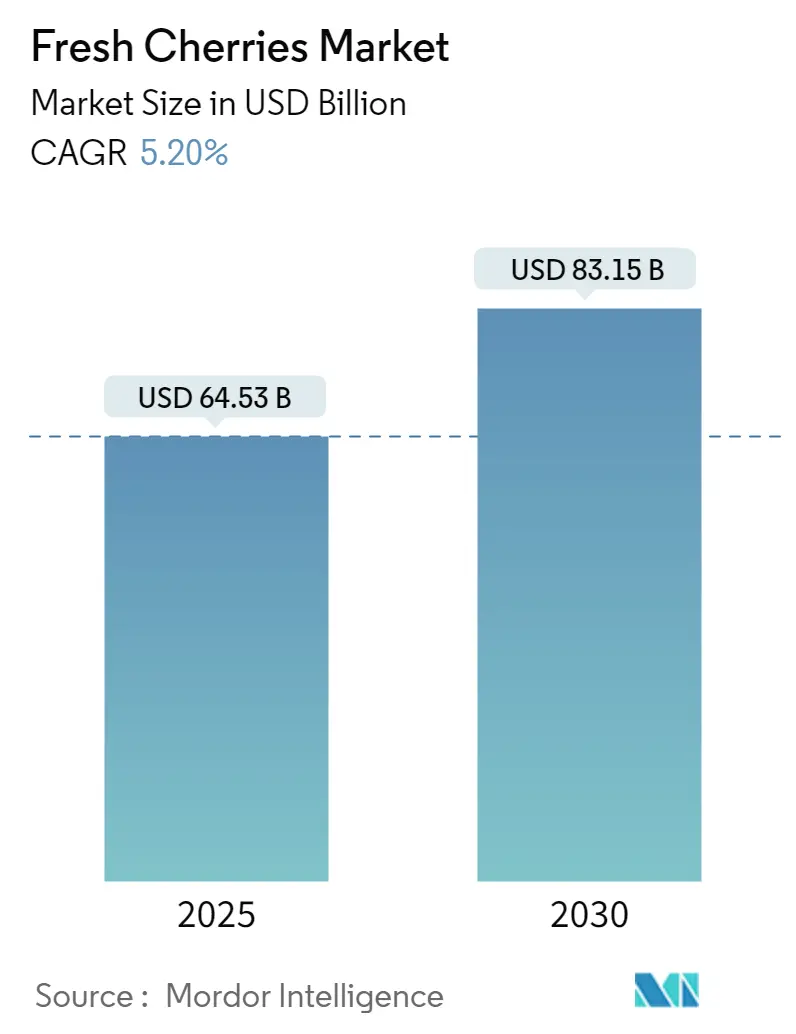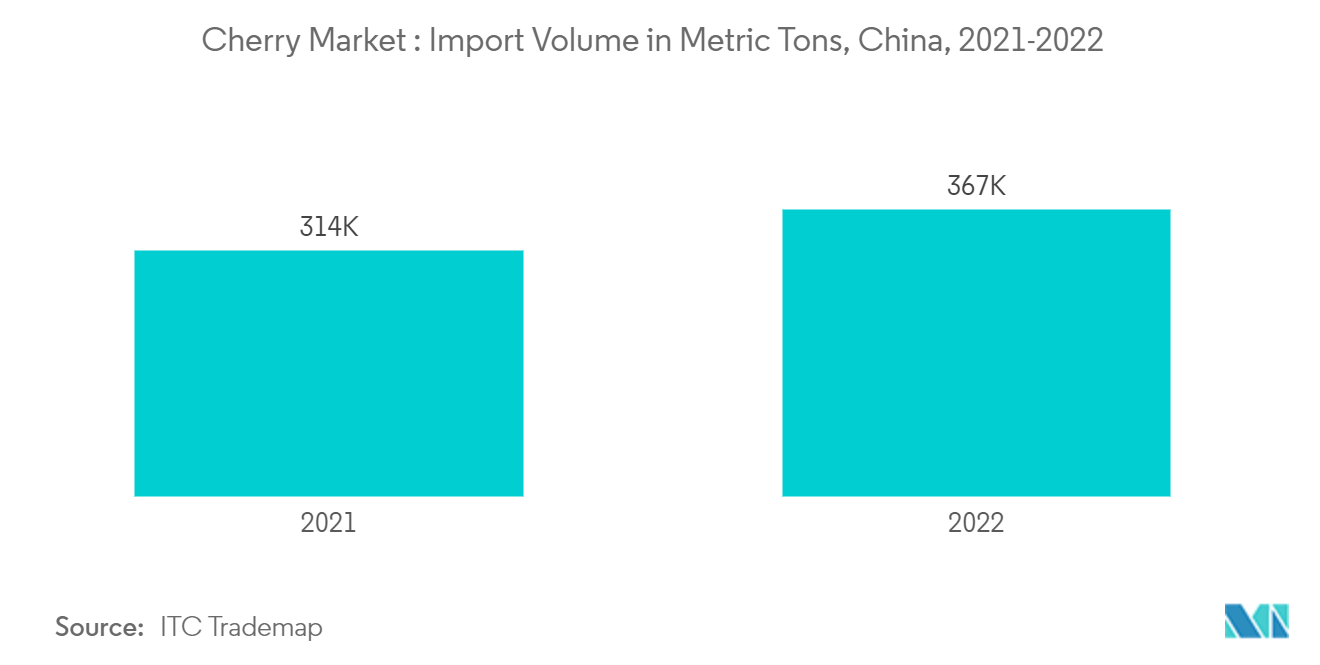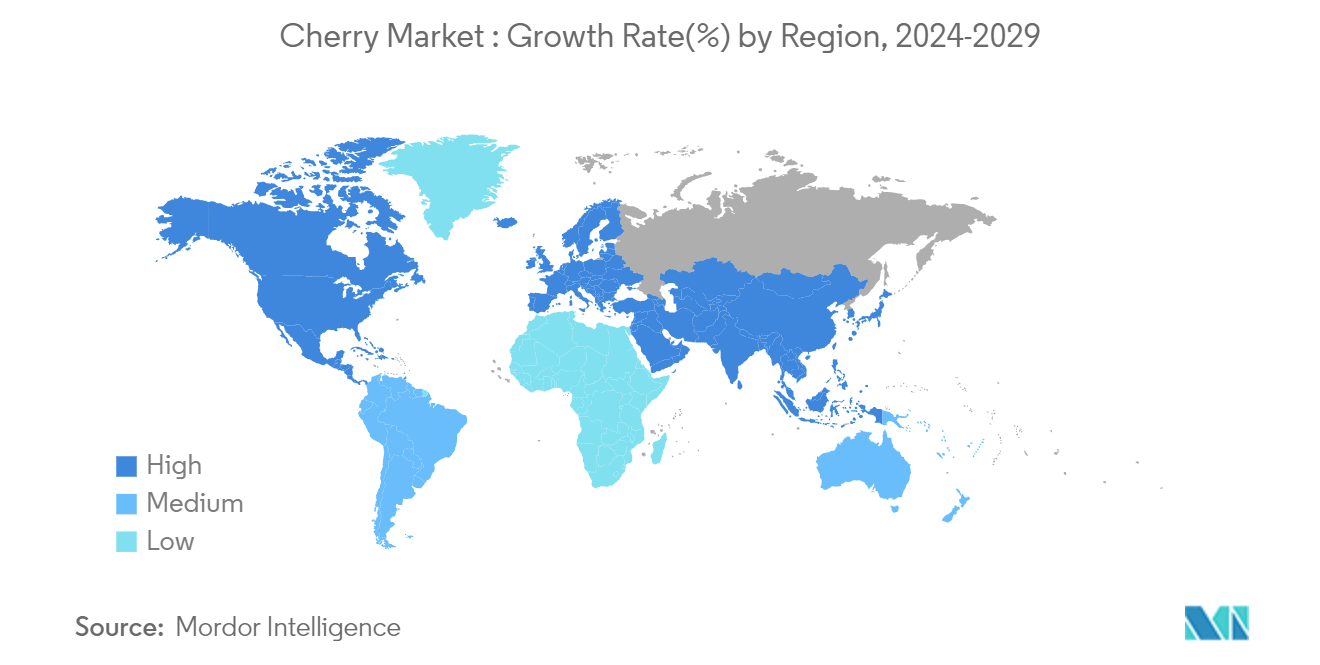Fresh Cherries Market Analysis
The Fresh Cherries Market size is estimated at USD 64.53 billion in 2025, and is expected to reach USD 83.15 billion by 2030, at a CAGR of 5.2% during the forecast period (2025-2030).
Cherry, a non-climacteric stone fruit from the genus Prunus, thrives predominantly in temperate climates. Renowned for its flavor, sweetness, vibrant color, and nutritional benefits, cherries are primarily enjoyed fresh. However, they can also be dried, pickled, or transformed into products like jam, marmalade, fruit juice, and canned goods. Globally, several cherry species are cultivated, including the sweet cherry (Prunus avium) and the sour or tart cherry (Prunus cerasus).
According to the Food and Agriculture Organization (FAO), Turkey is the primary producer of fresh cherries, with a production of 656,041 metric tons in 2022. This was followed by Chile, Uzbekistan, the United States, and Spain, with production volumes of 443,067 metric tons, 216,867 metric tons, 210,190 metric tons, and 116,070 metric tons, respectively, during the same year.
Demand for imported cherries, particularly the larger and sweeter varieties like "Cherry Grand" and "Cherry Treat," has surged. This shift is largely due to a preference for fresh sweet cherries over the traditionally favored soft and sour varieties, which are more susceptible to weather changes and storage issues. As health consciousness rises and fresh beverages like smoothies gain popularity, the demand for fresh cherries is increasing. Furthermore, cherries play a pivotal role in diabetes management. The consumption aids in maintaining balanced blood sugar levels, making them a safe choice for people with diabetes despite their sugar content. The American Diabetes Association (ADA) advocates for cherries in a low glycemic index (GI) diet. Low-GI foods, like cherries, release glucose into the bloodstream gradually, helping stabilize sugar levels. The benefits of cherries for those with diabetes are underscored by their low fat content and high fiber and vitamin C levels, all of which are endorsed by both the ADA and the Centers for Disease Control and Prevention (CDC). The rising consumption is directly linked to the increased cultivation of premium-quality and innovative cherry varieties, propelling the market’s growth.
Fresh Cherries Market Trends
Increasing Demand for Imported Sweet Cherries
The market is witnessing a surge in demand for imported regional varieties, with Turkey and the United States as the primary sources. Major importing and consuming nations, notably Europe and China, are driving this demand. The Food and Agriculture Organization (FAO) reported that in 2023, Turkey exported 215 thousand metric tons of cherries, generating USD 83 million in revenue. This success can be attributed to heightened investments and an expanding cultivation area, both spurred by robust export demand. Turkish cherries, especially the Napoleon, Ziraat 900, and Regina varieties, are celebrated for their large size, vibrant deep red hue, and delightful sweetness. Their size and flavor profile make Turkish cherries a favored choice, whether for fresh consumption or diverse culinary applications.
Cherries hold significant importance as a daily fresh fruit in China. Major imports come from Chile, largely due to a zero-tariff free trade agreement established in 2021 and Chile's optimal ripening period from November to January, coinciding with China's Spring Festival celebrations. Data from the ITC Trade Map revealed that China imported 334,000 metric tons of fresh cherries from Chile, amounting to a value of USD 255 million. Renowned for their consistent quality, deep color, and sweet flavor, Chilean cherries are available from November to February, perfectly timing with the Chinese New Year festivities. To cater to the surging domestic demand, China also ramped up imports from countries like Kyrgyzstan, Uzbekistan, and Tajikistan. Notably, these cherries, cultivated with fewer pesticides, boast high quality.
In the United States, cherry varieties such as "Cherry Grand" and "Cherry Treat" are gaining popularity. These varieties are not only larger but also sweeter than the traditional "Chelan" variety. This heightened appeal has led to increased demand from neighboring countries such as China and Japan. The global surge in demand for fresh cherries has translated into heightened sales of imported cherries, prized for their larger size and sweeter taste. Additionally, as cherries are perceived as a convenient and nutritious choice, the growing trend of healthy snacking further propels the market’s growth.
Turkey is the Leader in Cherry Production
Turkey is the world's leading cherry producer, closely followed by Chile. According to the Food and Agricultural Organization, in 2022, Turkey's cherry production reached 656,041 metric tons, followed by Chile at 443,067 metric tons. Turkey's varied climates and soils create optimal conditions for cultivating several cherry varieties, notably the sought-after Napoleon, Ziraat 900, and Regina varieties. Cherry cultivation thrives in Turkey's North Anatolian and Taurus mountains. Cherries flourish naturally on the slopes and river valleys of the North Anatolian Mountains, the Western and Central Taurus Mountains, and at elevations of 1,000-1,500 meters on the Mediterranean side of the Eastern Taurus Mountains, ensuring harvests of exceptional quality.
The cherry season in Turkey commences in late May and continues until early August, with the specific duration influenced by regional variances and weather patterns. Typically, the pinnacle of cherry harvesting in Turkey occurs during June. Renowned as one of the leading global producers of cherries, Turkey exports its harvest to numerous nations, including Europe and the Middle East.
Additionally, Turkey has made significant strides in cherry production technology, solidifying its status as a top global cherry producer. The country has evolved from traditional methods to modern high-density orchards. These state-of-the-art orchards, utilizing dwarfing rootstocks and sophisticated training systems, boost yields and enhance fruit quality. Furthermore, Turkey has pioneered cutting-edge automated packaging technologies for cherries, markedly improving efficiency and quality control. For instance, in 2024, Turkish cherry packhouse StePacPPC launched its Xflow technology with an automated packing and grade-sorting system that addresses the pressing need for streamlined operations while maximizing productivity. Such innovations have cemented Turkey's leadership in the global cherry market, consistently delivering high-quality produce that aligns with international standards.
Fresh Cherries Market News
- September 2024: Jack Daniel’s launched the Jack & Coca-Cola Cherry Classic ready-to-drink canned cocktail. This offering harmoniously blends the robust notes of Tennessee whiskey with the fruity undertones of Coca-Cola Cherry.
- May 2024: TOMRA launched an AI-driven LUCAi platform, boosting the precision of cherry sorting and grading for the California and New Zealand markets. With LUCAi, cherries are meticulously sorted, packaged in optimal boxes, and primed for the best market prices.
- April 2024: Chick-fil-A introduced a selection of four new Cherry Berry options on its menu in celebration of the spring season, showcasing a variety of delicious berry flavors. These additions include the Cherry Berry Sunjoy beverage, Cherry Berry Lemonade, Cherry Berry Iced Tea, and Cherry Berry Frosted Lemonade.
Fresh Cherries Industry Segmentation
Fresh cherries are small stone fruits that come in a variety of colors and flavors. There are two major categories - tart and sweet cherries, or Prunus cerasus L. and Prunus avium L., respectively.
The fresh cherries market is segmented by geography (North America, Europe, Asia-Pacific, South America, and the Middle East and Africa. The report offers production analysis (volume), consumption analysis (value and volume), import analysis (value and volume), export analysis (value and volume), and price trend analysis. The report offers market size and forecasts in terms of value (USD) and volume (metric tons) for all the above segments.
| Geography | North America | United States | Production Analysis | |
| Consumption Analysis (Volume & Value) | ||||
| Import Market Analysis (Volume & Value) | ||||
| Export Market Analysis (Volume & Value) | ||||
| Price Trends Analysis | ||||
| Canada | Production Analysis | |||
| Consumption Analysis (Volume & Value) | ||||
| Import Market Analysis (Volume & Value) | ||||
| Export Market Analysis (Volume & Value) | ||||
| Price Trends Analysis | ||||
| Europe | Spain | Production Analysis | ||
| Consumption Analysis (Volume & Value) | ||||
| Import Market Analysis (Volume & Value) | ||||
| Export Market Analysis (Volume & Value) | ||||
| Price Trends Analysis | ||||
| Italy | Production Analysis | |||
| Consumption Analysis (Volume & Value) | ||||
| Import Market Analysis (Volume & Value) | ||||
| Export Market Analysis (Volume & Value) | ||||
| Price Trends Analysis | ||||
| Germany | Production Analysis | |||
| Consumption Analysis (Volume & Value) | ||||
| Import Market Analysis (Volume & Value) | ||||
| Export Market Analysis (Volume & Value) | ||||
| Price Trends Analysis | ||||
| United Kingdom | Production Analysis | |||
| Consumption Analysis (Volume & Value) | ||||
| Import Market Analysis (Volume & Value) | ||||
| Export Market Analysis (Volume & Value) | ||||
| Price Trends Analysis | ||||
| Russia | Production Analysis | |||
| Consumption Analysis (Volume & Value) | ||||
| Import Market Analysis (Volume & Value) | ||||
| Export Market Analysis (Volume & Value) | ||||
| Price Trends Analysis | ||||
| Asia-Pacific | China | Production Analysis | ||
| Consumption Analysis (Volume & Value) | ||||
| Import Market Analysis (Volume & Value) | ||||
| Export Market Analysis (Volume & Value) | ||||
| Price Trends Analysis | ||||
| India | Production Analysis | |||
| Consumption Analysis (Volume & Value) | ||||
| Import Market Analysis (Volume & Value) | ||||
| Export Market Analysis (Volume & Value) | ||||
| Price Trends Analysis | ||||
| Japan | Production Analysis | |||
| Consumption Analysis (Volume & Value) | ||||
| Import Market Analysis (Volume & Value) | ||||
| Export Market Analysis (Volume & Value) | ||||
| Price Trends Analysis | ||||
| Australia | Production Analysis | |||
| Consumption Analysis (Volume & Value) | ||||
| Import Market Analysis (Volume & Value) | ||||
| Export Market Analysis (Volume & Value) | ||||
| Price Trends Analysis | ||||
| South America | Chile | Production Analysis | ||
| Consumption Analysis (Volume & Value) | ||||
| Import Market Analysis (Volume & Value) | ||||
| Export Market Analysis (Volume & Value) | ||||
| Price Trends Analysis | ||||
| Brazil | Production Analysis | |||
| Consumption Analysis (Volume & Value) | ||||
| Import Market Analysis (Volume & Value) | ||||
| Export Market Analysis (Volume & Value) | ||||
| Price Trends Analysis | ||||
| Argentina | Production Analysis | |||
| Consumption Analysis (Volume & Value) | ||||
| Import Market Analysis (Volume & Value) | ||||
| Export Market Analysis (Volume & Value) | ||||
| Price Trends Analysis | ||||
| Middle East and Africa | Turkey | Production Analysis | ||
| Consumption Analysis (Volume & Value) | ||||
| Import Market Analysis (Volume & Value) | ||||
| Export Market Analysis (Volume & Value) | ||||
| Price Trends Analysis | ||||
| United Arab Emirates | Production Analysis | |||
| Consumption Analysis (Volume & Value) | ||||
| Import Market Analysis (Volume & Value) | ||||
| Export Market Analysis (Volume & Value) | ||||
| Price Trends Analysis | ||||
| South Africa | Production Analysis | |||
| Consumption Analysis (Volume & Value) | ||||
| Import Market Analysis (Volume & Value) | ||||
| Export Market Analysis (Volume & Value) | ||||
| Price Trends Analysis | ||||
Fresh Cherries Market Research FAQs
How big is the Fresh Cherries Market?
The Fresh Cherries Market size is expected to reach USD 64.53 billion in 2025 and grow at a CAGR of 5.20% to reach USD 83.15 billion by 2030.
What is the current Fresh Cherries Market size?
In 2025, the Fresh Cherries Market size is expected to reach USD 64.53 billion.
What years does this Fresh Cherries Market cover, and what was the market size in 2024?
In 2024, the Fresh Cherries Market size was estimated at USD 61.17 billion. The report covers the Fresh Cherries Market historical market size for years: 2019, 2020, 2021, 2022, 2023 and 2024. The report also forecasts the Fresh Cherries Market size for years: 2025, 2026, 2027, 2028, 2029 and 2030.
Our Best Selling Reports
Cherry Industry Report
Statistics for the 2025 Fresh Cherries market share, size and revenue growth rate, created by Mordor Intelligence™ Industry Reports. Fresh Cherries analysis includes a market forecast outlook for 2025 to 2030 and historical overview. Get a sample of this industry analysis as a free report PDF download.





